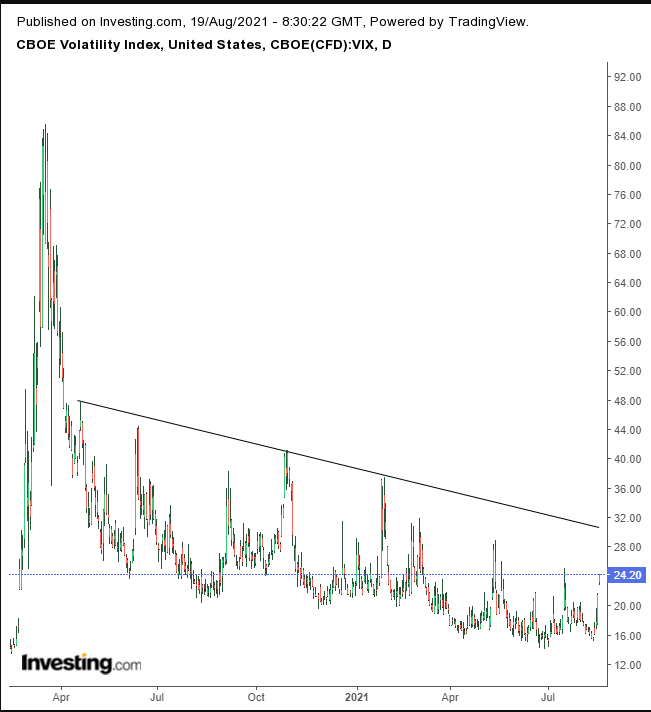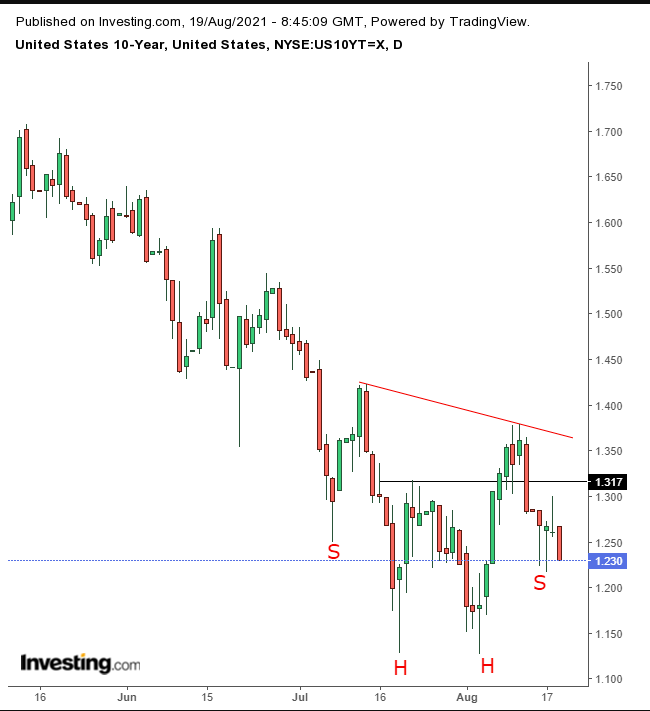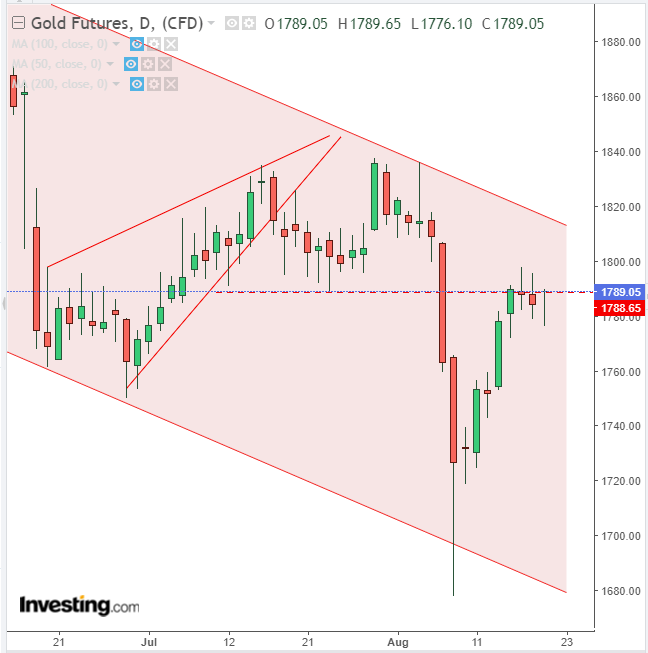- Fed minutes reveal most FOMC members ready to taper this year
- Treasuries and VIX jump
- Oil continues to slide
- The FTSE 100 dropped 2.0%
- The STOXX 600 fell 1.3%
- Futures on the S&P 500 fell 0.7%
- Futures on the NASDAQ 100 fell 0.7%
- Futures on the Dow Jones Industrial Average fell 0.7%
- The MSCI Asia Pacific Index fell 1.8%
- The MSCI Emerging Markets Index fell 2%
- The British pound fell 0.4% to $1.3701
- The Dollar Index rose 0.4%
- The euro fell 0.3% to $1.1677
- The Japanese yen fell 0.1% to 109.88 per dollar
- The offshore yuan fell 0.2% to 6.4986 per dollar
- Britain’s 10-year yield declined three basis points to 0.54%
- The yield on 10-year Treasuries declined two basis points to 1.23%
- Germany’s 10-year yield was little changed at -0.49%
- Brent crude fell 2.1% to $66.80 a barrel
- Spot gold fell 0.4% to $1,779.79 an ounce
Key Events
Futures contracts on the Dow, S&P, NASDAQ and Russell 2000 as well as global stocks fell in pre-US open trading on Thursday after the Fed minutes revealed the US central bank is preparing to slow stimulus, and the spread of the Delta variant of COVID-19 continues to damage global economic growth.
Yields slumped two basis points, and the dollar is now trading at a nine-month high.
Global Financial Affairs
All four US futures were deeply in the red. Contracts on the Russell 2000 sagged the most, over 1.2%, while NASDAQ 100 futures slid just 0.43% as investors rotated back into the market darlings of the pandemic even though any tapering of Fed stimulus will render already highly valued tech stocks even more expensive.
This is noteworthy as technology stocks have already pushed the envelope on valuations in a dovish market. So, investors who expect a repeat of last year's fantastic gains may be disappointed as the Fed’s safety net is removed.
The VIX opened higher and extended its rally to over 7%.

We’re not seeing a reversal yet, but at this point the contract are trading within the natural ebb and flow of a downtrend.
Stocks in Europe tumbled, losing over 1%, as investors rushed to reprice shares based on the change in timeframe for tapering quantitative easing.
The STOXX 600 Index dropped 1.7%, its lowest level in two weeks, with miners leading the charge lower, losing 3.8% of value in their worst trading day in three months.
Earlier, Asian equities plummeted to this year’s lowest levels, with Hong Kong’s Hang Seng plunging 2.1%.
US stocks sank yesterday after the Fed minutes were published. However in contrast to futures this morning, smaller, domestic firms outperformed, with the Russell 2000 edging down just 0.6%, while the NASDAQ slid 0.9%. This provides yet another example of how market sentiment has been encompassing conflicting trends and influences.
Nevertheless, by looking at the bigger picture rather than a single day’s session, small caps have still outperformed this year, though they're currently taking the brunt of the selloff.

The Russell 2000 fell for the fifth straight day, reinforcing the downside breakout of a top.
Yields on the 10-year Treasury note extended a drop, as investors rotated out of stocks and back into safe haven Treasuries.

Notice that despite the drop, yields remain above this week’s lows, keeping a potential H&S bottom a reality.
The dollar strengthened, reaching its highest level since November. However, the greenback gave up half of its gains, demonstrating the resistance of a neckline to a massive double bottom.

Note, the USD might be forming the first half of a much smaller H&S top, which could push it back for a third bottom.
Gold rebounded sharply, as the dollar trimmed its earlier advance, threatening to end a two-day selloff.

However, the onus is on bulls, as the price curved downward, having approached the top of a falling channel and the precious metal's July lows.
After capping a decline, Bitcoin developed a High Wave candle.

The move demonstrated a potential upward reversal off the bottom of the rising channel, providing an ideal long position from a risk-reward perspective.
The strengthened dollar, ongoing social restrictions and rising gas inventories combined to weigh on the price of oil, forcing it into a sixth straight decline.

Crude completed a top, forming a Descending triangle.
